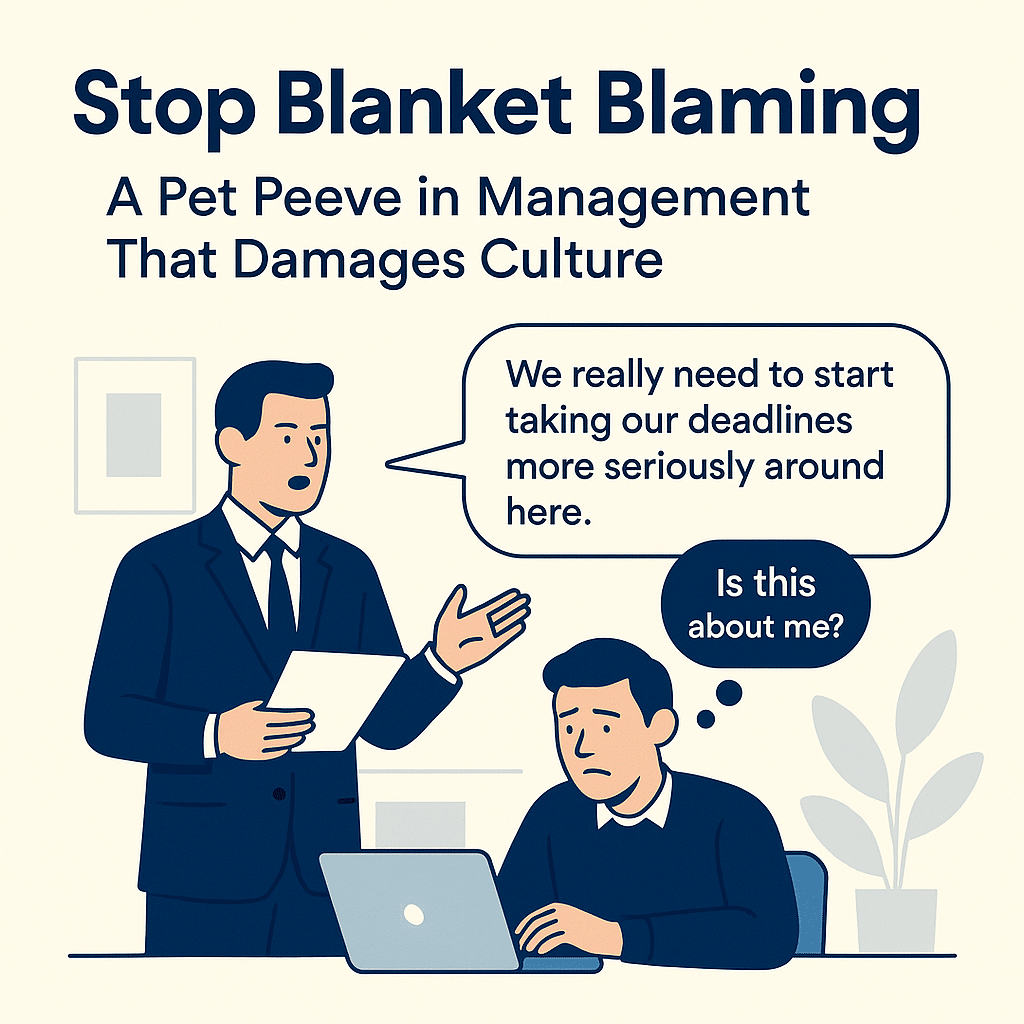Blanket blaming in companies is a bigger problem than many companies realize, and many people don’t realize it’s even happening.
Have you ever been in a meeting, just wrapping up your updates, feeling pretty good about your contributions—and then, wham! Your manager drops a comment like: “We really need to start taking our deadlines more seriously around here.”
Or worse, you get one of those vague but ominous emails:
“Hey team, I’ve noticed some people are not keeping up with documentation. This is unacceptable. We all need to do better.”
You pause. You always hit deadlines. You take pride in your documentation. So you sit there, re-reading the email and wondering, “Is this about me?”
And just like that, your motivation dims a little.

The Problem with Blanket Blaming Corrections
This is one of my biggest pet peeves in management: blanket blaming corrections meant for one person, delivered to an entire team.
Managers often do this to avoid direct conflict. Maybe they hope the person who needs to hear it will read between the lines and magically adjust their behavior. But what actually happens is quite the opposite.
Let’s break down the impact:
1. Your High-Achievers Suffer with Blanket Blaming
These are the people who go above and beyond. The ones who read every message carefully and hold themselves to a high standard. When they receive vague, corrective communication, they immediately self-reflect. “Did I do something wrong?” They feel bad. They may even apologize for something they didn’t do. After a few of these incidents, confusion turns into frustration. They begin to feel unappreciated and micromanaged. Worst-case scenario: they disengage.
2. The Real Offender Ignores It
Ironically, the person who actually needs the feedback? They don’t even flinch. They assume it’s about someone else—or that it isn’t serious. They think, “If it was about me, my manager would’ve told me directly.” And so the behavior continues unchecked.
3. The Culture Starts to Erode
Over time, blanket corrections create a toxic undercurrent in team dynamics. Trust erodes. People start assuming the worst. You can’t build a culture of transparency and accountability if people don’t know where they stand or what’s expected of them.
Example: The Documentation Dilemma
Let’s say one person on the team—let’s call him Jake—has been consistently skipping steps in documenting his work. Instead of having a one-on-one conversation with Jake, the manager sends this email to the entire team:
“Documentation is crucial. Lately, I’ve noticed a few folks aren’t doing their part. Let’s remember that proper documentation helps everyone.”
Here’s how different people on the team interpret that:
- Maya, the high-achiever: “Wait—did I forget to document something? I thought I was doing great. I’m going to spend extra time double-checking my work now…”
- Liam, the new hire: “Wow, I must have already messed up and didn’t realize it. This is intimidating.”
- Jake (the actual issue): “Eh. I’m sure this is about someone else. No big deal.”
- Olivia, the quiet one: Says nothing, but silently grows resentful that there’s no clarity.
No one wins in this scenario. Except maybe Jake.
So What Should You Do Instead of Blanket Blaming?
1. Be Direct (and Kind)
If Jake is the problem, talk to Jake. Don’t talk to everyone but Jake. It may feel uncomfortable in the moment, but a well-placed one-on-one conversation is more respectful and effective than a public guessing game.
Say something like:
“Hey Jake, I’ve noticed a few recent tickets missing documentation. I want to make sure you have what you need to be successful with that part of the process. Can we walk through what’s expected and see how I can help?”
This not only addresses the issue, but shows care and willingness to support.
2. Use Praise Publicly, Feedback Privately
Celebrate great work in team settings. Use specific, individualized feedback for corrections. This reinforces a positive culture where people feel seen for what they’re doing right—and held accountable when needed.
3. Foster a Culture of Open Communication
Set expectations early: “If I have a concern, I’ll bring it to you directly. And I encourage you to do the same.” Encourage team members to talk to each other about roadblocks, not just funnel everything up to you.
Leadership is Not About Avoiding Conflict—It’s About Handling It Well
Being a leader isn’t easy. It takes courage to address issues head-on. But hiding behind blanket messages doesn’t make you conflict-averse—it makes you conflict-avoidant. And that avoidance creates far more conflict down the road than one honest conversation would.
Remember: Communication Isn’t Communication Unless It’s Heard
It’s not just about what you say. It’s about whether the right person hears it—and understands it the way you meant it.
So next time you’re tempted to send a team-wide email about “certain behaviors” or “areas for improvement,” pause. Ask yourself:
- Who is this really about?
- What message do I want that person to hear?
- And how can I deliver it in a way that builds clarity, trust, and growth?
Leadership isn’t about loud, vague declarations to the room. It’s about real conversations with real people. And that takes clarity, courage, and a whole lot of empathy.

